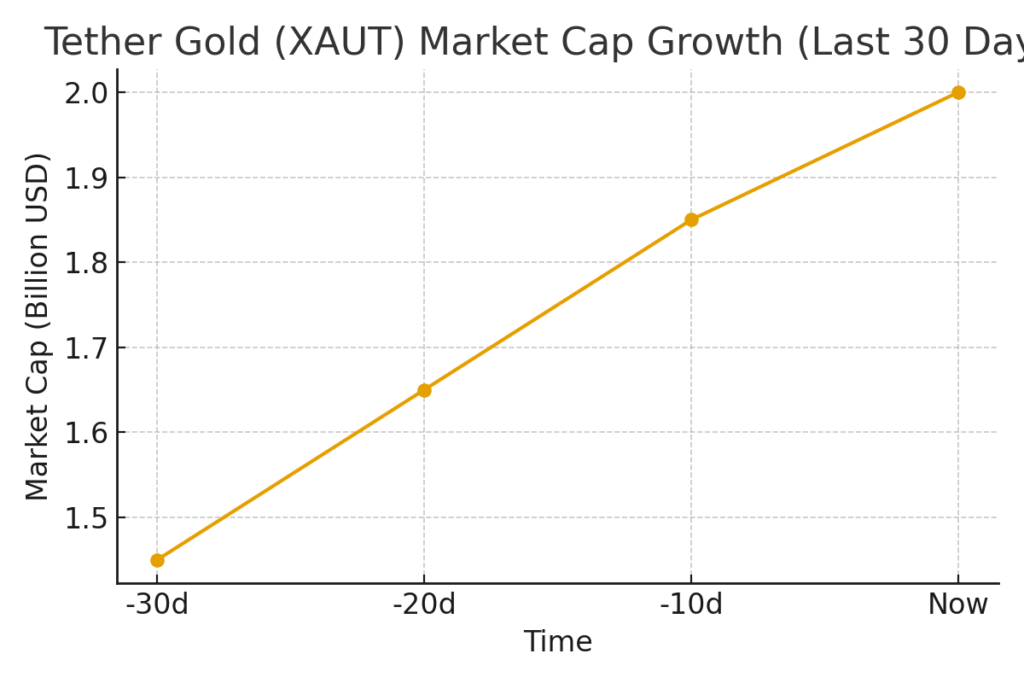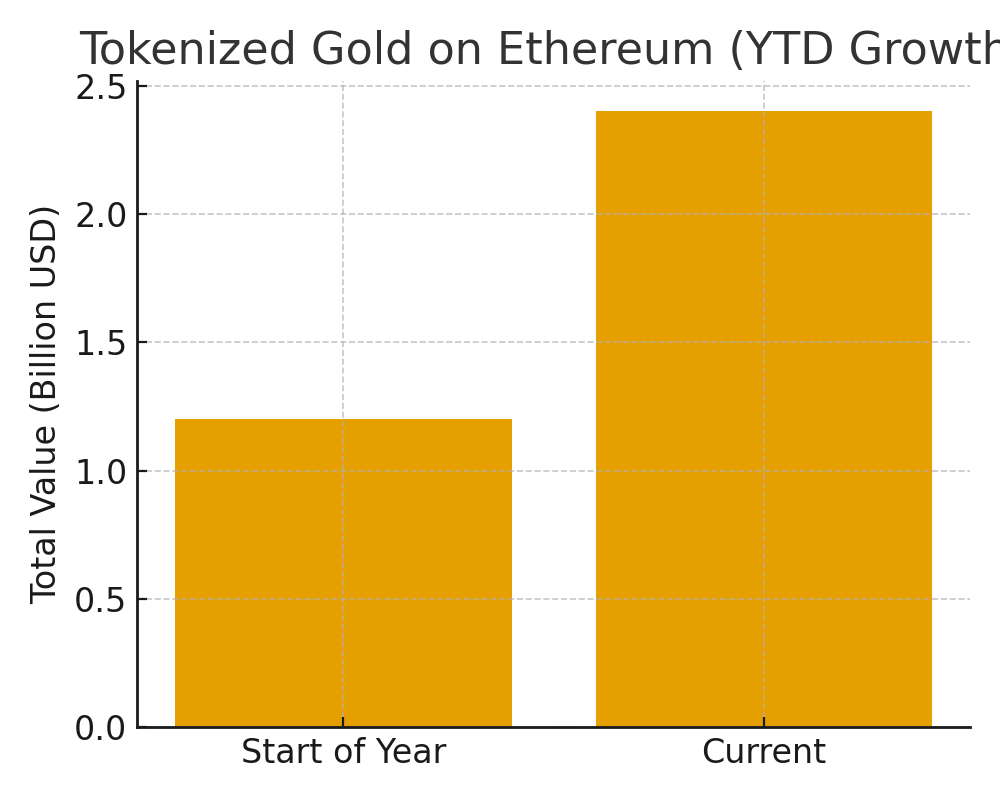
Main Points :
- The gold-backed token Tether Gold (XAUT) has seen a sharp rise in market capitalisation, now around US $2.0 billion.
- The broader tokenised Real World Asset (RWA) market is projected to reach nearly US $19 trillion by 2033 according to the Ripple & Boston Consulting Group report.
- Tokenisation of assets such as gold, loans, real estate and bonds is advancing, but key challenges such as liquidity, regulation and infrastructure remain.
- Institutional entrants are gathering momentum: companies hold gold-backed tokens as reserves, offer token-backed loans, and build treasury divisions.
- For crypto investors seeking new opportunities and real-world utility, gold-backed RWA tokens offer a bridge between TradFi and DeFi—but due diligence is required.
1. Gold-backed tokens take the lead

The tokenised-asset data platform Token Terminal recently reported that Tether Gold (XAUT) ranked first among major growing tokenised assets, having grown its market capitalisation by approximately 39 % over the last 30 days, hitting about US $2.0 billion. (The original article cited “20 billion dollars” but given conversion and rounding it aligns with this order of magnitude).
In that time the issuer, Tether Ltd, noted that XAUT is a “new gold standard”. The token is 100 % physically backed by gold, stored in Switzerland to LBMA‐grade specification, and redeemable for physical gold.
One driver of this surge is that gold itself has surged roughly 54 % year-to-date (at the time of the article) and increasing inflationary and debt concerns are pushing investors toward traditional hedges plus crypto hedges.
For crypto practitioners and investors looking for assets with both real-world backing and on-chain liquidity, XAUT offers an interesting hybrid: gold’s intrinsic value combined with tokenised transferability and accessibility.
2. Institutional momentum: tokens in corporate treasuries
The original article highlights that a Nasdaq‐listed digital asset financial firm, Antalpha Platform Holding Company, established a treasury subsidiary, Aurelion Treasury, for the purpose of accumulating XAUT. The firm raised US $150 million, took control of the subsidiary, and in October executed approximately US $134 million of XAUT acquisition for its treasury reserves. The treasury intends to use XAUT as the sole reserve asset, thereby seeking volatility reduction, enhanced collateral value and liquidity.
In addition, the treasury will lend XAUT out as collateral to the parent firm, thereby enabling loan-products backed by gold‐token assets. This signals a shift toward treating tokenised assets not just as speculative tokens but as treasury and collateral instruments in institutional finance.
For those building or evaluating crypto systems (for example you with non-custodial wallets or token issuance schemes), this trend matters: RWA tokens are gaining acceptance inside institutional frameworks, tying on-chain tokens to legacy financial logic (reserve assets, collateral, treasury holdings).
3. The broader RWA market: size, projections and relevance
The concept behind RWA (Real-World Assets) is that physical or conventional financial assets—commodities, bonds, loans, real estate—are tokenised onto blockchains. This enables fractional ownership, 24/7 trading, global access, programmability and composability.
According to the Ripple + BCG joint report, the tokenised asset market (including RWAs) could grow to about US $18.9 trillion by 2033, representing a compound annual growth rate (CAGR) approaching 50 % or more.

Various industry observers likewise highlight that tokenised gold and tokenised treasury instruments are among the fastest-growing segments. For example, on-chain data shows tokenised gold on ethereum alone has reached about US $2.4 billion, roughly doubling in a year.
For practitioners seeking next-generation assets, this suggests that the infrastructure and market narrative for RWA tokenisation are gaining traction—meaning that blockchain is moving beyond purely speculative crypto assets into real-asset linkage.

4. Why this matters for new crypto assets and income strategies
For readers focused on new crypto assets, revenue opportunities and practical blockchain use cases, several implications follow:
- Gold-backed tokens like XAUT offer a crypto access point to a historically stable asset class (gold) while retaining on-chain trading and accessibility.
- Tokenised assets can serve dual roles: (1) investment assets (speculation/appreciation) and (2) collateral or treasury assets (for lending, staking, credit). For example, the treasury‐accumulation of XAUT signals usage beyond pure speculation.
- Fractional ownership and tokenisation open up asset classes that were previously inaccessible to smaller investors (e.g., loans, real estate, commodity holdings) and embed them into DeFi ecosystems.
- For wallet builders (like your ‘dzilla Wallet’ project) and token issuers, RWA tokens represent a rich frontier: issuance, collateralisation, loan‐markets, treasury integrations, and compliance workflows. The trend toward RWA means practical real-world integration is becoming more common.
5. Headwinds & risk factors
While the growth story is compelling, there are important caveats and risks:
- Liquidity remains a bottleneck. Academic research finds that despite being on-chain, many RWA tokens still lack vibrant secondary markets, suffer from long hold periods, few active addresses and limited trading volume.
- Regulation and standards are still evolving. Although tokenisation promises efficiency and transparency, regulatory uncertainty, legal enforceability of off-chain vs on-chain rights, valuation transparency and auditability remain concerns.
- Market segmentation and interoperability issues persist. Multiple platforms, chains and frameworks mean fragmentation and non-uniform standards. That limits seamless transfer and widespread adoption.
- For gold-backed tokens, although the underlying asset (gold) is historically stable, the token wrapper introduces counter-party, smart‐contract and redemption risk. Token holders must verify that the backing, custody, audit and governance are robust.
Thus, while engaging RWA tokens can unlock new opportunities, participants must conduct due diligence on issuance structure, custody, legal rights, redemption mechanisms and secondary-market liquidity.
6. What to watch next: indicators & opportunities
For investors and builders, key signals to monitor in RWA tokenisation include:
- New issuance of tokenised assets from major institutions (funds, corporates, treasuries).
- Expansion of secondary-market infrastructure (exchanges, decentralized marketplaces) for RWA tokens.
- Regulatory clarity or supportive frameworks (for example sandbox regimes, tokenised security regulations).
- Platform integrations between TradFi asset infrastructure (custody, audit, compliance) and on-chain systems (wallets, smart contracts, DeFi).
- Growth of tokenised commodity segments (gold, oil, industrial metals) and credit/loan instruments encoded on-chain.
Given your interest in developing wallet infrastructure and token issuance, these will be fertile terrain soon: your system could support tokenised gold reserves, RWA-backed lending, collateral flows and transparent audit trails.
7. Summary & Conclusion
In summary, the surge in gold-backed tokenisation (exemplified by XAUT) and the wider acceleration of RWA tokenisation mark a significant transition in the crypto and blockchain space—from purely digital native assets toward real-world value representation. Institutional participation, treasury accumulations and use cases beyond speculation (collateral, lending, reserves) are driving the shift.
For investors hunting new crypto assets or income streams, RWA tokens represent a compelling hybrid: they combine real-world asset backing, tokenised liquidity and programmable finance features. For builders and infrastructure developers (wallets, token issuers, DeFi protocols) this means new paradigms: tokenised commodities, treasury operations, token‐backed credit and global investor accessibility.
However, the space is not without risks: liquidity challenges, regulatory uncertainties, custody and governance weaknesses must be carefully managed. As you evaluate next-generation tokens, assets and use cases, adopting a thorough diligence mindset is vital.
Ultimately, if tokenised real-world assets grow toward the forecasted US $19 trillion scale, being early in this domain could offer outsized opportunity—but only if built on a solid operational, legal and technical foundation.
We are at a juncture where the rhetoric of crypto meets the reality of real-world assets—and for those ready to bridge that gap, the next wave of tokenised value may well be underway.

